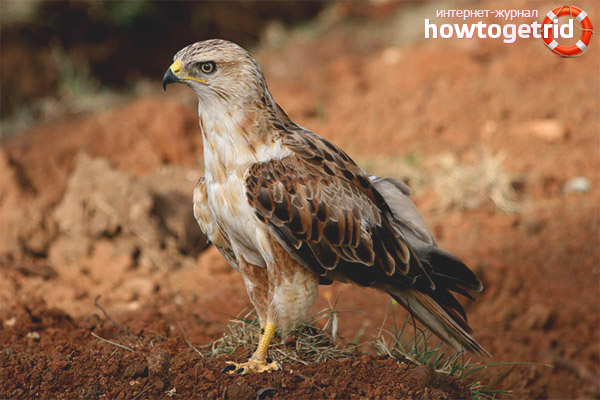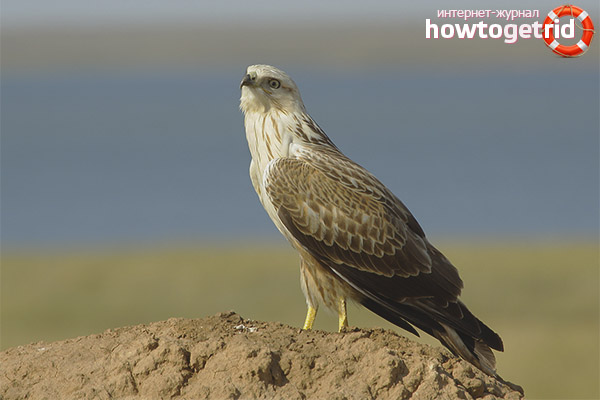The content of the article
The Kurgan is a bird of prey, the size of an adult reaches 65 centimeters, the width of its wingspan is 160 centimeters, and weight can reach up to 1800 grams. As a rule, the female exceeds the size of the male in length and shape of the wings. This bird resembles an eagle; it has an elongated tail model and long legs.
The features of this bird include various dominant shades of plumage, according to which some representatives of the Buzzard are attributed to light varieties, and others to dark ones.
The light-legged Buzzard is distinguished by a reddish-ocher shade of plumage, its head is lighter in tone than the back or chest, and its abdomen and sides, on the contrary, are darker. The tail of the bird has a light plumage of a reddish color, there are no transverse stripes on it. In the lower part of its wings, a large white spot is clearly distinguished, which consists of swirls of fly feathers.
You can also meet these birds, the colors of which are dominated by dark tones - in the color of their feathers a decisive role is played by a black-brown hue. Feathers of a light color are located in the lower part of the wings of such buzzards, and a dark border located on the edge of the wing gives them contrast. Light feathers also make up the tail of this bird, plus it is decorated with dark stripes located across. On the fly, the dark longhorn can be easily confused with a winter buzzard or even a buzzard, but its characteristic body shape and the absence of a lunate configuration on the chest give it away.
It is easy to distinguish young individuals from adults by lighter plumage, there is no red tint in their color, the abdomen has light plumage, the tail is decorated with small stripes, characteristic spots and borders on the wings are absent. In the upper part of the wings, young individuals have light spots resembling the coloring of young winter beetles.
Distinctive features characterizing the nutrition of the Buzzard
In winter, when the amount of prey decreases markedly, these birds do not disdain carrion, making up for the missing amount in the diet. These birds prefer to hunt from the sky, overtaking their prey with the help of a sudden peak. In the event of a miss, they may continue to pursue the land.
Bird habitats
Kurgan is a bird that has become widespread, it can be found in North Africa, in Greece, in the desert regions of Turkey, in the steppes, as well as in the forest-steppe regions of Eurasia, starting from the Black Sea zones, ending with the Caucasus, in the western part of Mongolia and in the deserts of Arabian peninsula.
Mounds living in areas with moderate climate conditions during the winter season make seasonal flights to more southern areas, they prefer semi-desert regions located on the African continent, which are located south of the Sahara. In addition, these birds are sent for wintering in the northern regions of India. They set off on their return trip with the onset of spring, but not all representatives of this species need seasonal flights.
For their settlements, Kurgan can choose both mountain ranges and plain expanses of the steppes, as well as semi-deserts.Even desert areas are no exception if there is enough food for food. In the Balkans, these birds nest in the forests, among the mountainous regions located at an average height. For a comfortable living, representatives of this species need open areas for successful hunting and nooks where they can arrange their nests. You can meet these hunters at altitudes reaching 2700 meters compared to sea level.
Most often, the choice of the Kurgan stops on open land, where he easily manages to get his prey. He arranges his nests on the ledges of rocks, steep slopes of ravines, although he can easily use power poles or various towers for this purpose. If necessary, the bird can make a nest even on the ground.
The population of birds of this species is constantly in a changing position, on the territory of the Russian Federation, for example, there is a tendency to decrease in numbers, for this reason it is listed in the Red Book.
Gender differences in birds
The female Buzzard, in contrast to the male, is larger. The male is approximately 20% smaller than his female. Only this characteristic serves as a distinctive feature of sexual dimorphism in these birds. After all, any differences expressed in the color of their plumage do not exist.
Nesting
Breeding
At the beginning of April, the female lays eggs, her laying can number from 2 to 5 eggs. The eggs have a dirty white color, camouflaged brown with specks of different sizes. The incubation period of Buzzard eggs is 35 days; at its end, approximately in May or early June, chicks appear. They will be ready for independent life after 6 weeks.
Video: Buzzard (Buteo rufinus)











Submit